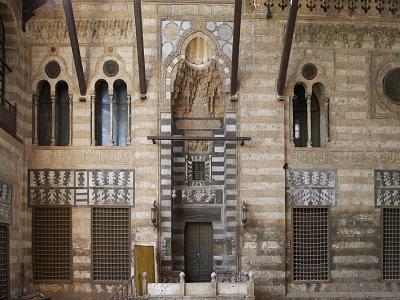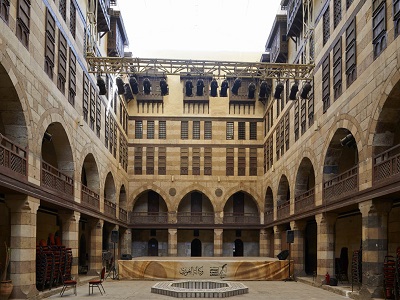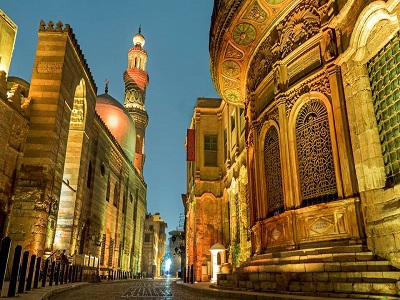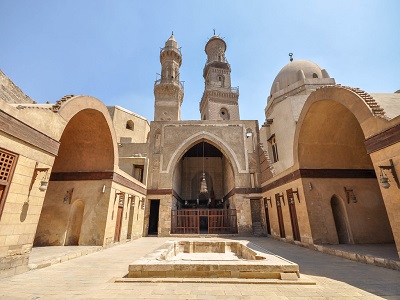Al-Ghouri Complex
Sultan
Qansuh Al-Ghouri was a Mamluk sultan, who had reigned from 1501 to 1516, before
dying in a battle against the Ottomans in Aleppo, which resulted in a complete
defeat for the Mamluks, due to which they lost their prominence in Egypt.
Al-Ghouri
spent a fortune on building his complex in Cairo which dates back to 1503.
Although he was renowned for his cruelty and despotism, he was also known for
his love of flowers, music, poetry and architecture. His cultural refinement
emanates from the different features of the complex.
The
construction stands on both sides of Al-Mo'ez Street; the mosque and madrasa
stand on the western side, whereas you will find the Khanqah, mausoleum and
Sabil-Kuttab on the eastern side of the famous street. The mausoleum is however
not the final resting place of the Sultan, whose body was never recovered after
the Aleppo battle.


The two
parts of the complex aren’t adjusted to the street alignment, thus creating a
free shaped courtyard in between the two buildings. The mosque’s minaret has
four stories, just like the original minaret of the Aqsunqur mosque (The Blue Mosque).
These are the only two minarets in Cairo known to have four stories, instead of
the usual three.
Since
1995, the complex hosts various cultural events in the Khanqah hall, mostly
Nubian music concerts, Tannoura dance performances, and religious recitals.
Source:
Egyptian Tourism Authority
Qalawun Complex
Al-Mo'ez
Street in Cairo houses a fascinating complex that reflects the greatness of the
Mamluk architecture which is the Qalawun Complex. It consists of a mosque, a
madrasa, a mausoleum, and a hospital. It has two sections
The
Qalawun Complex was built by the order of Mansour Seif El-Din
Qalawun in 684 A.H (1285 AD). The
complex included a mausoleum to be a burial place for him and his family, a
madrasa for religious rituals and teaching different kinds of science, and a
maristan to cure all diseases and to teach medicine.


The oldest Hospital in Egypt
Qalawun
Maristan is the oldest hospital in Egypt, and there are many stories of why it
was built. Some argued that Sultan Al-Mansour built the hospital as an
atonement for his sins, according to Ibn Iyas in his book "Badai Alzuhur
Fi Wakayi Alduhur".
Others argued
that the reason behind building the hospital is that when Qalawun was visiting the
Levant " Billad El-Sham", he got severely ill. He was then treated by
doctors and medicines brought from Nour El-Din Mohammad Maristan in Damascus. After he recovered, he visited the maristan,
and he was impressed by it. So, he vowed to God that he would build a similar
hospital when he becomes the king. Qalawun established the hospital for all
kinds of treatment, but in 1856 it became a mental hospital.
Qalawun
Maristan had doctors of all specialties, nurses, and necessary equipment and
medicines. Recently, nothing left of the hospital except for some ruined parts
like a section of the eastern iwan consisting of a marble fountain
and a shadirwan (wall fountain) decorated with fine marble and resembled that
in al-Aziz Palace (Zisa) in Palermo, Sicily.
Sitt Al-Mulk:
Qalawun chose Sitt al-Mulk hall to build the maristan.
The hall belonged to Sitt al-Mulk, a daughter of the
Fatimid Caliph, al-Aziz bi Allah, which later became a possession of Mo'anisa
Khatun, a daughter of Al-Malik Al-Adel Al-Ayyubi. The hall was situated at the
end of the complex and consisted of four iwans.
The mausoleum's dome is the most significant part of
the Qalawun Complex. It consists of an octangle base on four marble square
pillars that have four columns covered with fine marble. the external facade
was made of red and white square stones and the minaret made up of three stories.


